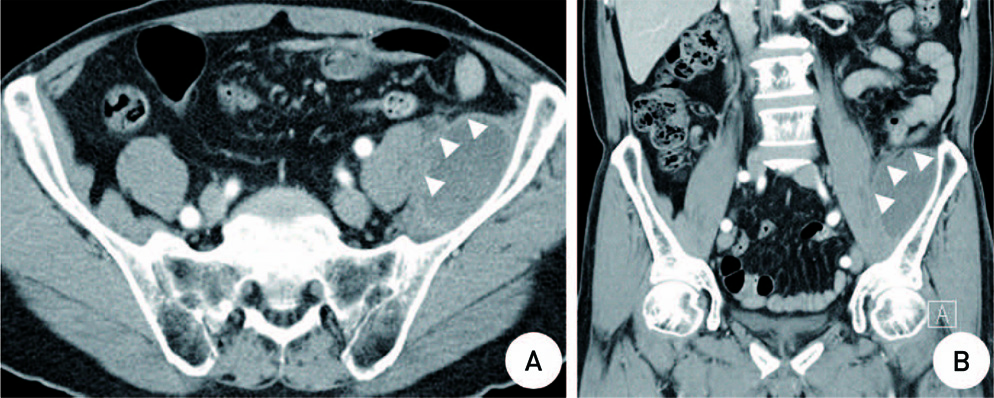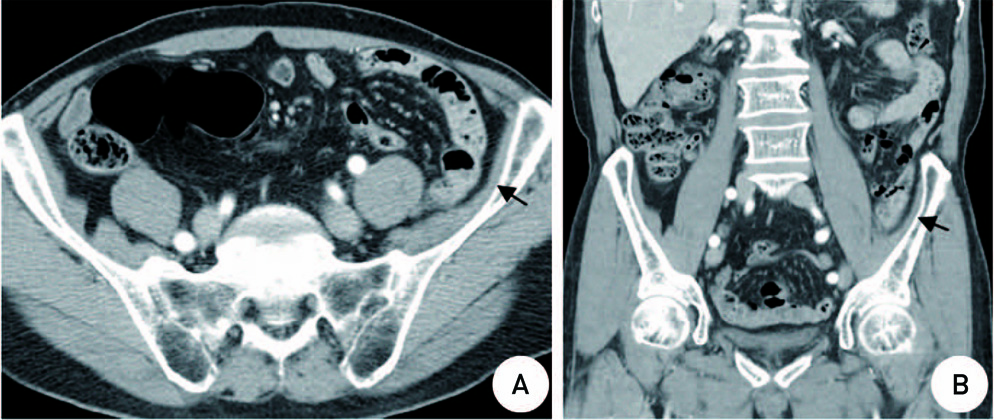Hip Pelvis.
2014 Mar;26(1):50-54. 10.5371/hp.2014.26.1.50.
Non-operative Treatment of Femoral Neuropathy Caused by Iliacus Hematoma: A Case Report
- Affiliations
-
- 1Department of Orthopaedic Surgery, The Catholic University of Korea, Yeouido St. Mary's Hospital, Korea. sykwon@catholic.ac.kr
- 2Department of Orthopaedic Surgery, Seoul Daeyoon Hospital, Korea.
- KMID: 2054163
- DOI: http://doi.org/10.5371/hp.2014.26.1.50
Abstract
- Treatment of femoral neuropathy caused by iliacus hematoma can be divided according to operative treatment and non-operative treatment. Recently, percutaneous drainage has been more popular because it is relatively simple, convenient, and less invasive. After warfarin overuse, a 71-year-old male patient visited the emergency room with femoral neuropathy caused by a left iliacus muscle hematoma measuring approximately 110x64 mm, 75x60 mm in size on coronal and sagittal computed tomography angiograhy. Without trauma, weakness of the left hip flexor and left knee extensor was noted with strength of 2/5 (poor) each. Immediate medical treatment using vitamin K and fresh frozen plasma was started and percutaneous drainage was performed. Two days after visiting the emergency room, neurological symptoms were improved and non-operative treatment was continued. Twenty four days after being hospitalized, the size of the hematoma was reduced to approximately 75x45 mm, 62x40 mm in size. Approximately three months after hospitalization, most of the hematoma was absorbed. After one year, mild atrphy of quadriceps and mild diffuse pain were noted, however, no other symptoms were observed.
MeSH Terms
Figure
Reference
-
1. Ashrani AA, Osip J, Christie B, Key NS. Iliopsoas haemorrhage in patients with bleeding disorders--experience from one centre. Haemophilia. 2003; 9:721–726.
Article2. Balkan C, Kavakli K, Karapinar D. Iliopsoas haemorrhage in patients with haemophilia: results from one centre. Haemophilia. 2005; 11:463–467.
Article3. Guivarc'h M. Hematoma of the iliac psoas muscle. 29 cases. J Chir (Paris). 1997; 134:382–389.4. Marquardt G, Barduzal Angles S, Leheta F, Seifert V. Spontaneous haematoma of the iliac psoas muscle: a case report and review of the literature. Arch Orthop Trauma Surg. 2002; 122:109–111.
Article5. Nakao A, Sakagami K, Mitsuoka S, Uda M, Tanaka N. Retroperitoneal hematoma associated with femoral neuropathy: a complication under antiplatelets therapy. Acta Med Okayama. 2001; 55:363–366.6. Parmer SS, Carpenter JP, Fairman RM, Velazquez OC, Mitchell ME. Femoral neuropathy following retroperitoneal hemorrhage: case series and review of the literature. Ann Vasc Surg. 2006; 20:536–540.
Article7. Nobel W, Marks SC Jr, Kubik S. The anatomical basis for femoral nerve palsy following iliacus hematoma. J Neurosurg. 1980; 52:533–540.
Article8. Patel A, Calfee R, Thakur N, Eberson C. Non-operative management of femoral neuropathy secondary to a traumatic iliacus haematoma in an adolescent. J Bone Joint Surg Br. 2008; 90:1380–1381.
Article9. Kong WK, Cho KT, Lee HJ, Choi JS. Femoral neuropathy due to iliacus muscle hematoma in a patient on warfarin therapy. J Korean Neurosurg Soc. 2012; 51:51–53.
Article10. Wicky S, Mayor B, Schnyder P. Clinical impact of imaging iliopsoas hematomas during anticoagulation. Emerg Radiol. 1995; 2:2–6.
Article
- Full Text Links
- Actions
-
Cited
- CITED
-
- Close
- Share
- Similar articles
-
- Femoral Neuropathy due to Iliacus Muscle Hematoma in a Patient on Warfarin Therapy
- Iliacus Hematoma with Femoral Neuropathy in Hemophilia: A Case report
- Femoral Neuropathy and Meralgia Paresthetica Secondary to an Iliacus Hematoma
- Femoral Neuropathy Secondary to Iliacus Hematoma: A Case Report
- Femoral Neuropathy caused by Iliopsoas Hematoma: A Case Report




